Portfolio Theory: Modern Approaches to Investment and Risk Analysis
VerifiedAdded on 2023/05/29
|14
|2432
|240
Report
AI Summary
This report delves into portfolio theory, a modern approach for risk-averse investors to optimize returns based on market risk. It highlights that risk is integral to reward and discusses the creation of an efficient frontier of optimal portfolios. The assignment covers risk premium, sources of uncertainty in future payments, and the interdependence of asset allocation decisions. It contrasts conventional and risk-adjusted methods for evaluating portfolio performance, elucidates capital market instruments like shares, debentures, bonds, and derivatives, and outlines the characteristics of a good financial market. The report also differentiates between primary and secondary capital markets, explores the purposes of security market indexes, and defines the efficient capital market theory. Finally, it discusses industry analysis, using tools like ratio analysis and Porter's five forces model, and evaluates the impact of the business cycle on investment decisions, concluding that portfolio theory is crucial for informed investor decision-making.

Running head: PORTFOLIO THEORY
Portfolio Theory
Name of the Student:
Name of the University:
Author’s Note:
Course ID:
Portfolio Theory
Name of the Student:
Name of the University:
Author’s Note:
Course ID:
Paraphrase This Document
Need a fresh take? Get an instant paraphrase of this document with our AI Paraphraser
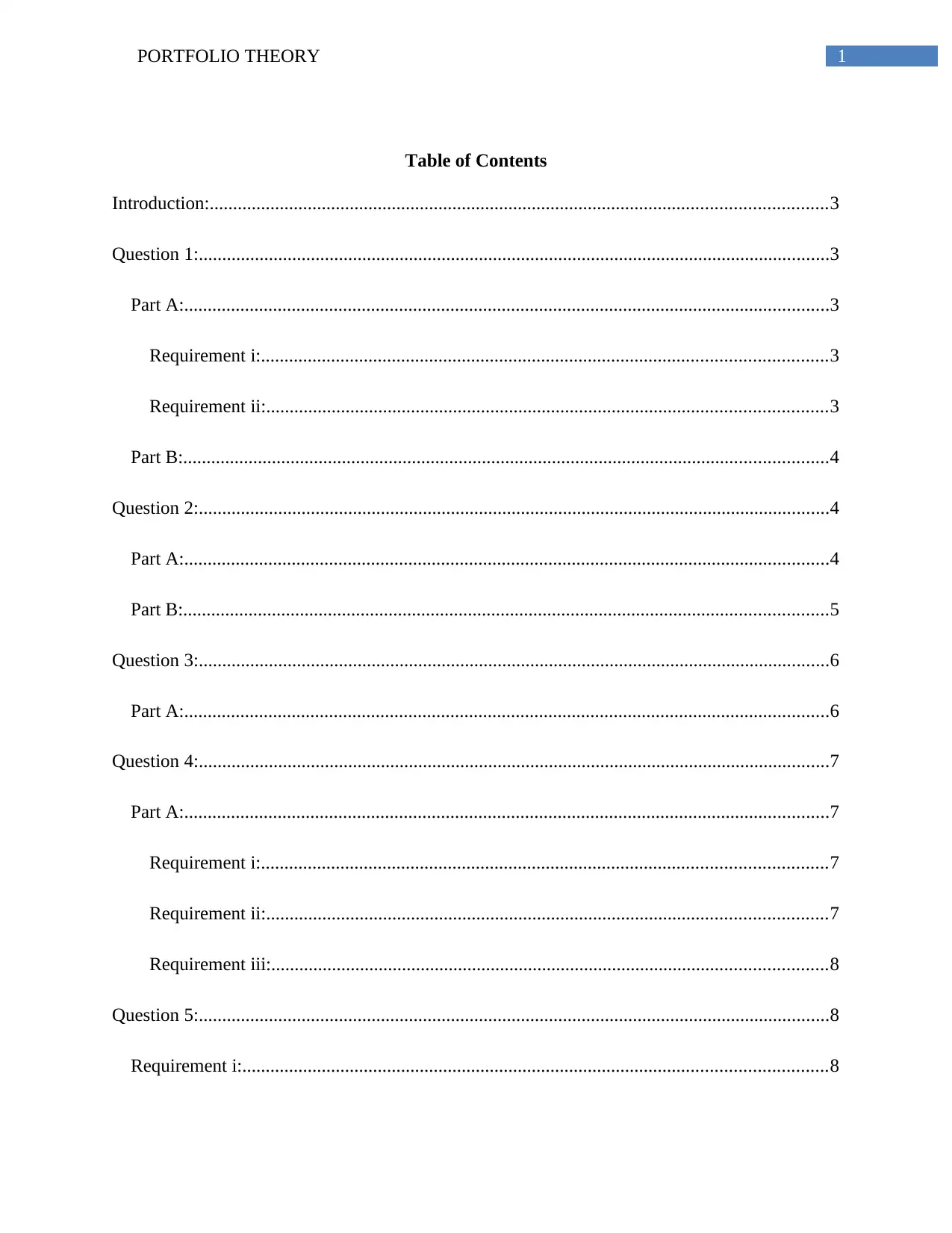
1PORTFOLIO THEORY
Table of Contents
Introduction:....................................................................................................................................3
Question 1:.......................................................................................................................................3
Part A:..........................................................................................................................................3
Requirement i:.........................................................................................................................3
Requirement ii:........................................................................................................................3
Part B:..........................................................................................................................................4
Question 2:.......................................................................................................................................4
Part A:..........................................................................................................................................4
Part B:..........................................................................................................................................5
Question 3:.......................................................................................................................................6
Part A:..........................................................................................................................................6
Question 4:.......................................................................................................................................7
Part A:..........................................................................................................................................7
Requirement i:.........................................................................................................................7
Requirement ii:........................................................................................................................7
Requirement iii:.......................................................................................................................8
Question 5:.......................................................................................................................................8
Requirement i:.............................................................................................................................8
Table of Contents
Introduction:....................................................................................................................................3
Question 1:.......................................................................................................................................3
Part A:..........................................................................................................................................3
Requirement i:.........................................................................................................................3
Requirement ii:........................................................................................................................3
Part B:..........................................................................................................................................4
Question 2:.......................................................................................................................................4
Part A:..........................................................................................................................................4
Part B:..........................................................................................................................................5
Question 3:.......................................................................................................................................6
Part A:..........................................................................................................................................6
Question 4:.......................................................................................................................................7
Part A:..........................................................................................................................................7
Requirement i:.........................................................................................................................7
Requirement ii:........................................................................................................................7
Requirement iii:.......................................................................................................................8
Question 5:.......................................................................................................................................8
Requirement i:.............................................................................................................................8
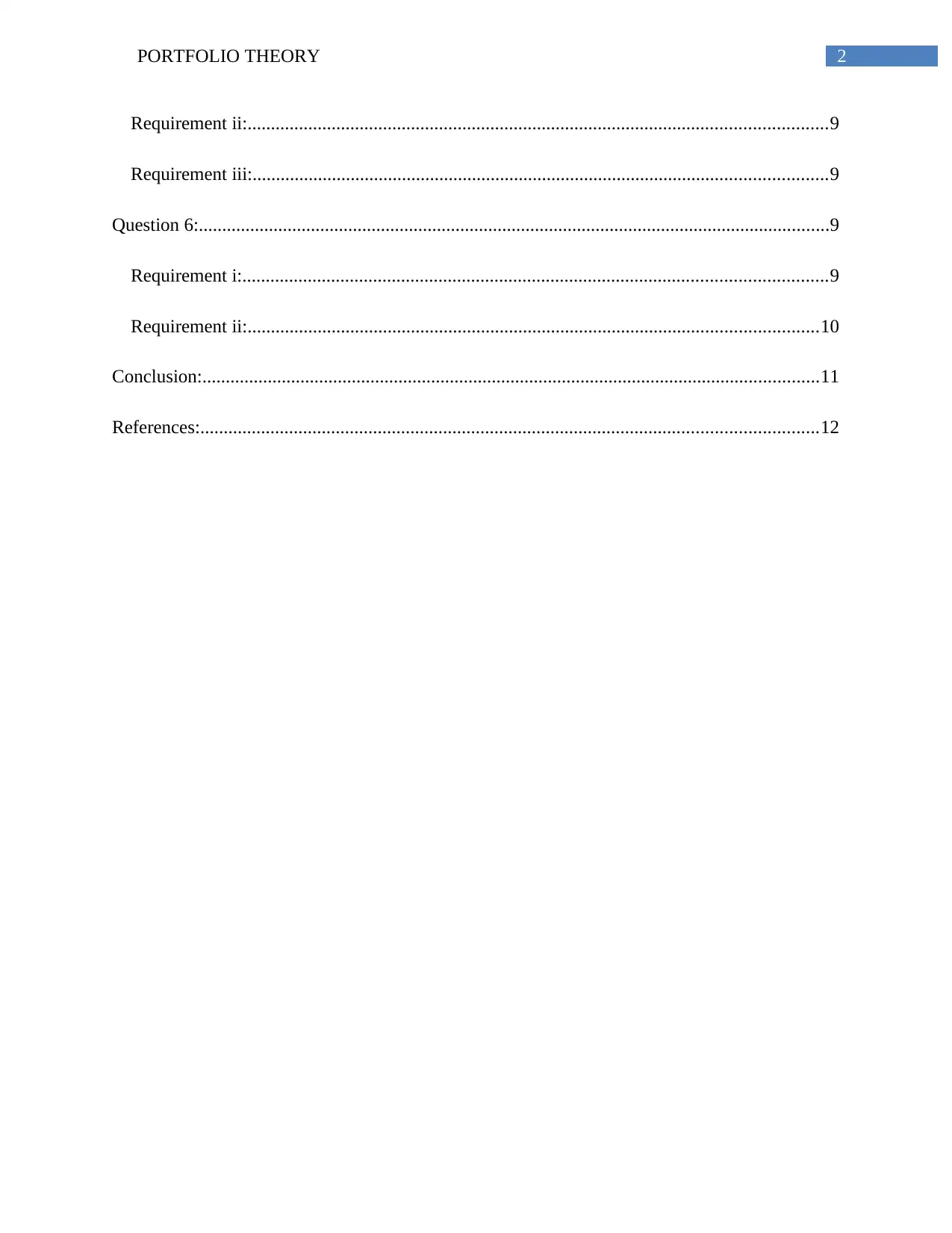
2PORTFOLIO THEORY
Requirement ii:............................................................................................................................9
Requirement iii:...........................................................................................................................9
Question 6:.......................................................................................................................................9
Requirement i:.............................................................................................................................9
Requirement ii:..........................................................................................................................10
Conclusion:....................................................................................................................................11
References:....................................................................................................................................12
Requirement ii:............................................................................................................................9
Requirement iii:...........................................................................................................................9
Question 6:.......................................................................................................................................9
Requirement i:.............................................................................................................................9
Requirement ii:..........................................................................................................................10
Conclusion:....................................................................................................................................11
References:....................................................................................................................................12
⊘ This is a preview!⊘
Do you want full access?
Subscribe today to unlock all pages.

Trusted by 1+ million students worldwide
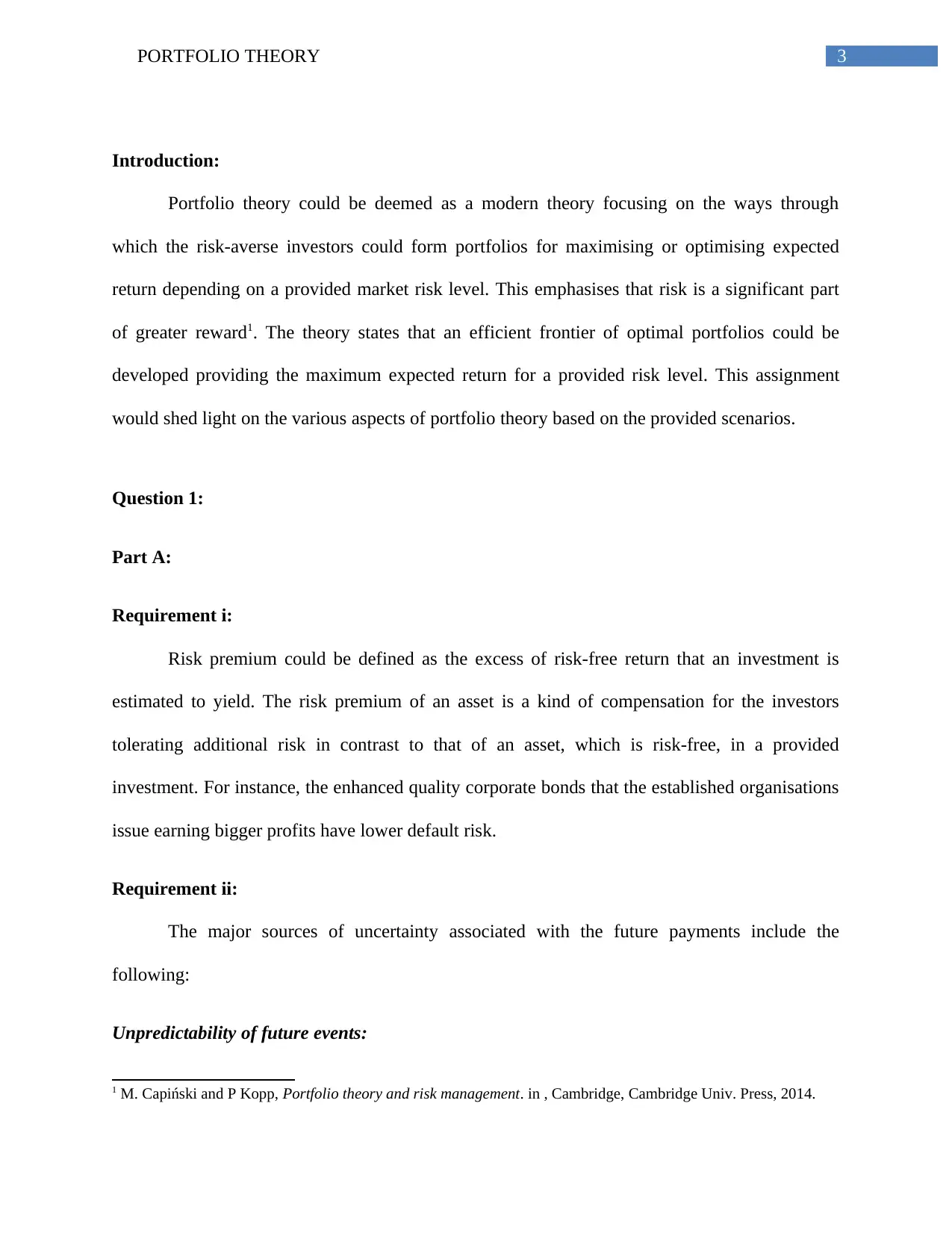
3PORTFOLIO THEORY
Introduction:
Portfolio theory could be deemed as a modern theory focusing on the ways through
which the risk-averse investors could form portfolios for maximising or optimising expected
return depending on a provided market risk level. This emphasises that risk is a significant part
of greater reward1. The theory states that an efficient frontier of optimal portfolios could be
developed providing the maximum expected return for a provided risk level. This assignment
would shed light on the various aspects of portfolio theory based on the provided scenarios.
Question 1:
Part A:
Requirement i:
Risk premium could be defined as the excess of risk-free return that an investment is
estimated to yield. The risk premium of an asset is a kind of compensation for the investors
tolerating additional risk in contrast to that of an asset, which is risk-free, in a provided
investment. For instance, the enhanced quality corporate bonds that the established organisations
issue earning bigger profits have lower default risk.
Requirement ii:
The major sources of uncertainty associated with the future payments include the
following:
Unpredictability of future events:
1 M. Capiński and P Kopp, Portfolio theory and risk management. in , Cambridge, Cambridge Univ. Press, 2014.
Introduction:
Portfolio theory could be deemed as a modern theory focusing on the ways through
which the risk-averse investors could form portfolios for maximising or optimising expected
return depending on a provided market risk level. This emphasises that risk is a significant part
of greater reward1. The theory states that an efficient frontier of optimal portfolios could be
developed providing the maximum expected return for a provided risk level. This assignment
would shed light on the various aspects of portfolio theory based on the provided scenarios.
Question 1:
Part A:
Requirement i:
Risk premium could be defined as the excess of risk-free return that an investment is
estimated to yield. The risk premium of an asset is a kind of compensation for the investors
tolerating additional risk in contrast to that of an asset, which is risk-free, in a provided
investment. For instance, the enhanced quality corporate bonds that the established organisations
issue earning bigger profits have lower default risk.
Requirement ii:
The major sources of uncertainty associated with the future payments include the
following:
Unpredictability of future events:
1 M. Capiński and P Kopp, Portfolio theory and risk management. in , Cambridge, Cambridge Univ. Press, 2014.
Paraphrase This Document
Need a fresh take? Get an instant paraphrase of this document with our AI Paraphraser
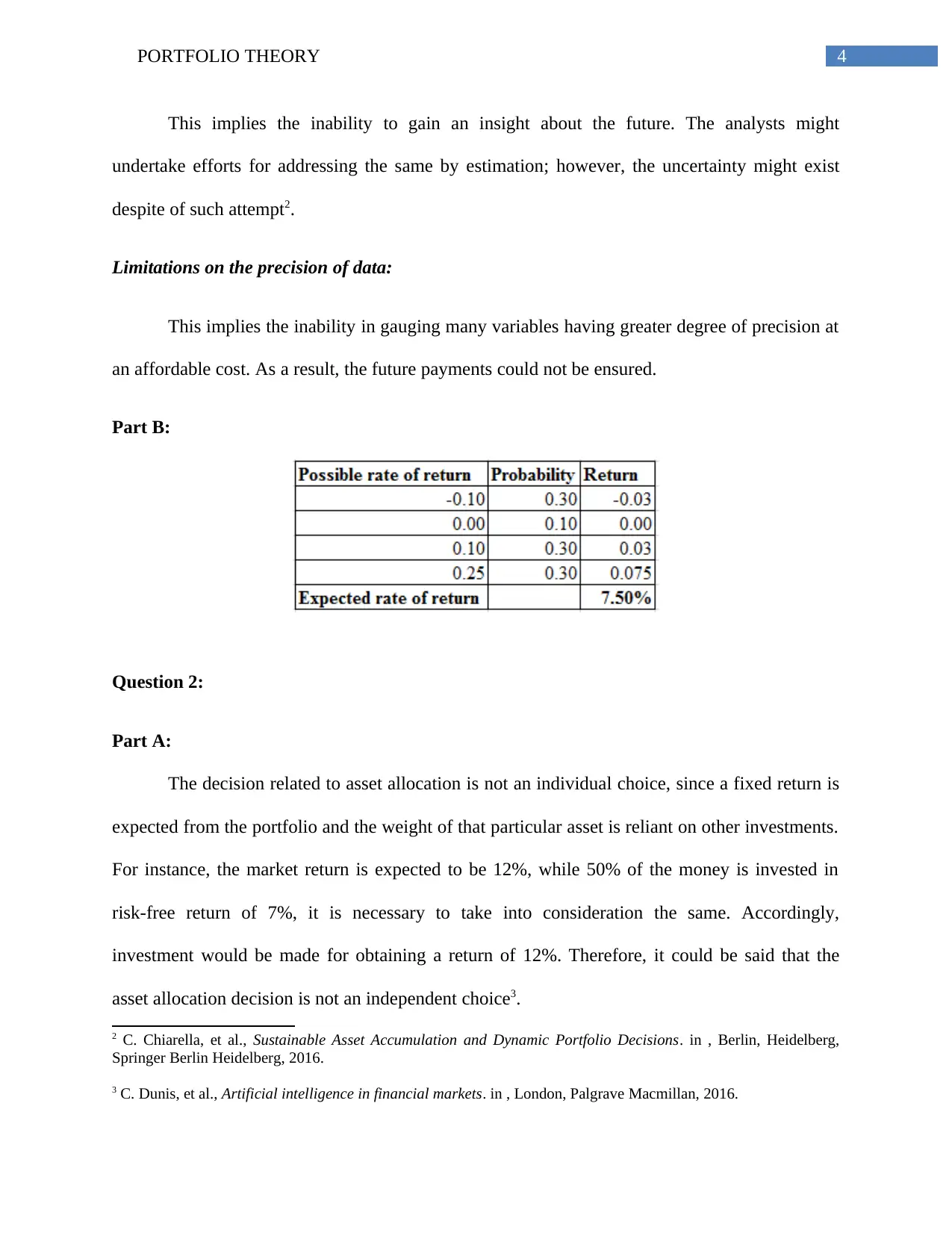
4PORTFOLIO THEORY
This implies the inability to gain an insight about the future. The analysts might
undertake efforts for addressing the same by estimation; however, the uncertainty might exist
despite of such attempt2.
Limitations on the precision of data:
This implies the inability in gauging many variables having greater degree of precision at
an affordable cost. As a result, the future payments could not be ensured.
Part B:
Question 2:
Part A:
The decision related to asset allocation is not an individual choice, since a fixed return is
expected from the portfolio and the weight of that particular asset is reliant on other investments.
For instance, the market return is expected to be 12%, while 50% of the money is invested in
risk-free return of 7%, it is necessary to take into consideration the same. Accordingly,
investment would be made for obtaining a return of 12%. Therefore, it could be said that the
asset allocation decision is not an independent choice3.
2 C. Chiarella, et al., Sustainable Asset Accumulation and Dynamic Portfolio Decisions. in , Berlin, Heidelberg,
Springer Berlin Heidelberg, 2016.
3 C. Dunis, et al., Artificial intelligence in financial markets. in , London, Palgrave Macmillan, 2016.
This implies the inability to gain an insight about the future. The analysts might
undertake efforts for addressing the same by estimation; however, the uncertainty might exist
despite of such attempt2.
Limitations on the precision of data:
This implies the inability in gauging many variables having greater degree of precision at
an affordable cost. As a result, the future payments could not be ensured.
Part B:
Question 2:
Part A:
The decision related to asset allocation is not an individual choice, since a fixed return is
expected from the portfolio and the weight of that particular asset is reliant on other investments.
For instance, the market return is expected to be 12%, while 50% of the money is invested in
risk-free return of 7%, it is necessary to take into consideration the same. Accordingly,
investment would be made for obtaining a return of 12%. Therefore, it could be said that the
asset allocation decision is not an independent choice3.
2 C. Chiarella, et al., Sustainable Asset Accumulation and Dynamic Portfolio Decisions. in , Berlin, Heidelberg,
Springer Berlin Heidelberg, 2016.
3 C. Dunis, et al., Artificial intelligence in financial markets. in , London, Palgrave Macmillan, 2016.
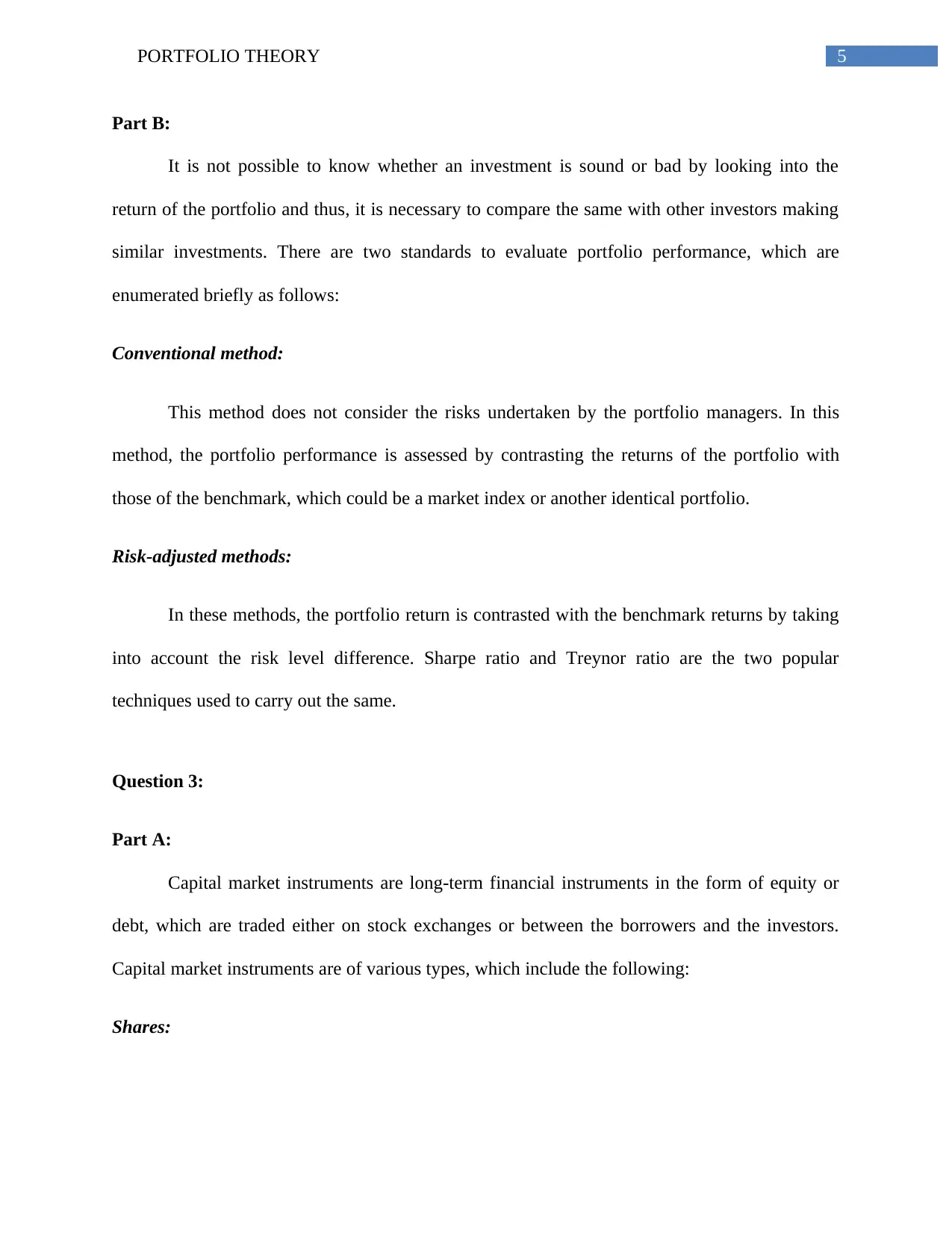
5PORTFOLIO THEORY
Part B:
It is not possible to know whether an investment is sound or bad by looking into the
return of the portfolio and thus, it is necessary to compare the same with other investors making
similar investments. There are two standards to evaluate portfolio performance, which are
enumerated briefly as follows:
Conventional method:
This method does not consider the risks undertaken by the portfolio managers. In this
method, the portfolio performance is assessed by contrasting the returns of the portfolio with
those of the benchmark, which could be a market index or another identical portfolio.
Risk-adjusted methods:
In these methods, the portfolio return is contrasted with the benchmark returns by taking
into account the risk level difference. Sharpe ratio and Treynor ratio are the two popular
techniques used to carry out the same.
Question 3:
Part A:
Capital market instruments are long-term financial instruments in the form of equity or
debt, which are traded either on stock exchanges or between the borrowers and the investors.
Capital market instruments are of various types, which include the following:
Shares:
Part B:
It is not possible to know whether an investment is sound or bad by looking into the
return of the portfolio and thus, it is necessary to compare the same with other investors making
similar investments. There are two standards to evaluate portfolio performance, which are
enumerated briefly as follows:
Conventional method:
This method does not consider the risks undertaken by the portfolio managers. In this
method, the portfolio performance is assessed by contrasting the returns of the portfolio with
those of the benchmark, which could be a market index or another identical portfolio.
Risk-adjusted methods:
In these methods, the portfolio return is contrasted with the benchmark returns by taking
into account the risk level difference. Sharpe ratio and Treynor ratio are the two popular
techniques used to carry out the same.
Question 3:
Part A:
Capital market instruments are long-term financial instruments in the form of equity or
debt, which are traded either on stock exchanges or between the borrowers and the investors.
Capital market instruments are of various types, which include the following:
Shares:
⊘ This is a preview!⊘
Do you want full access?
Subscribe today to unlock all pages.

Trusted by 1+ million students worldwide
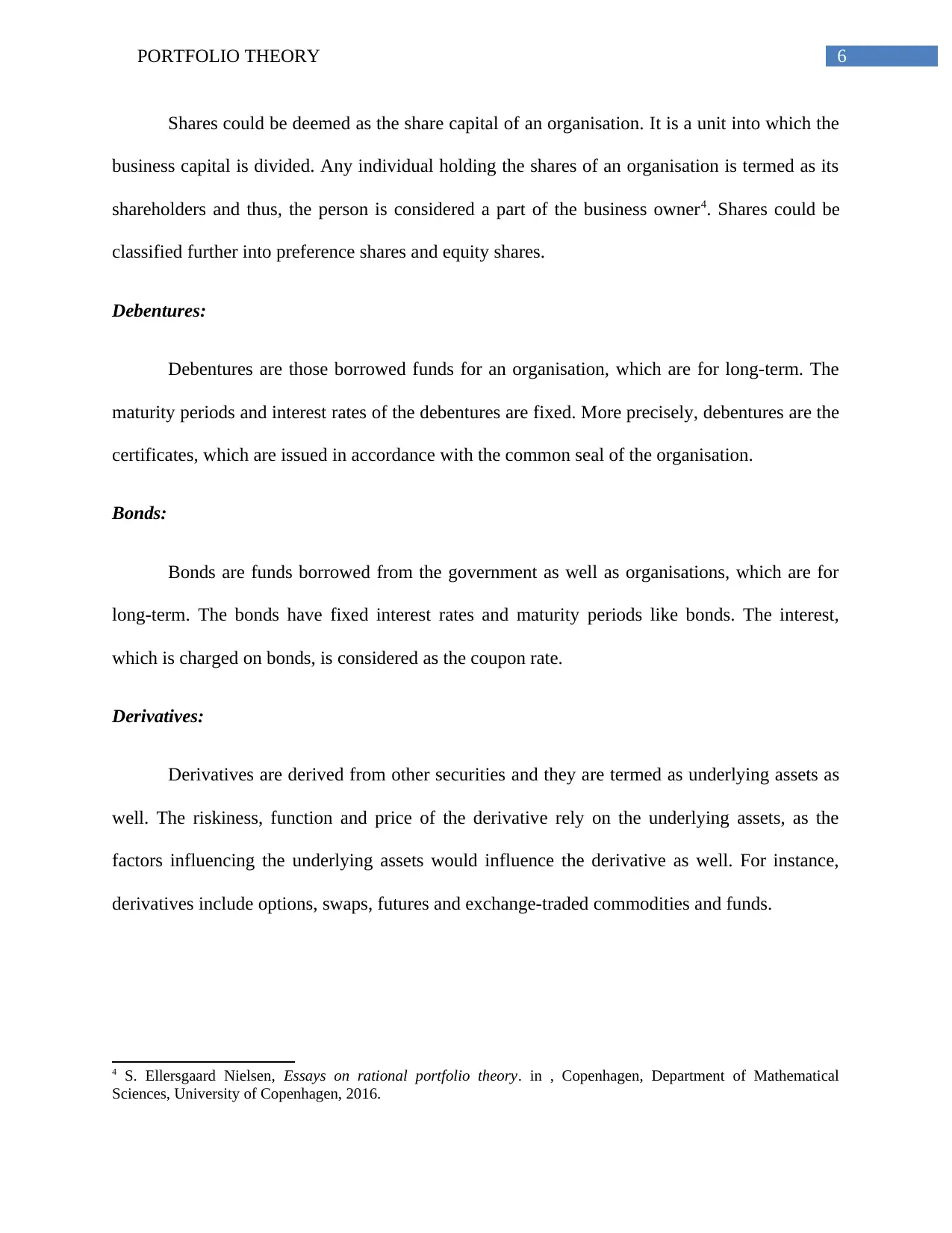
6PORTFOLIO THEORY
Shares could be deemed as the share capital of an organisation. It is a unit into which the
business capital is divided. Any individual holding the shares of an organisation is termed as its
shareholders and thus, the person is considered a part of the business owner4. Shares could be
classified further into preference shares and equity shares.
Debentures:
Debentures are those borrowed funds for an organisation, which are for long-term. The
maturity periods and interest rates of the debentures are fixed. More precisely, debentures are the
certificates, which are issued in accordance with the common seal of the organisation.
Bonds:
Bonds are funds borrowed from the government as well as organisations, which are for
long-term. The bonds have fixed interest rates and maturity periods like bonds. The interest,
which is charged on bonds, is considered as the coupon rate.
Derivatives:
Derivatives are derived from other securities and they are termed as underlying assets as
well. The riskiness, function and price of the derivative rely on the underlying assets, as the
factors influencing the underlying assets would influence the derivative as well. For instance,
derivatives include options, swaps, futures and exchange-traded commodities and funds.
4 S. Ellersgaard Nielsen, Essays on rational portfolio theory. in , Copenhagen, Department of Mathematical
Sciences, University of Copenhagen, 2016.
Shares could be deemed as the share capital of an organisation. It is a unit into which the
business capital is divided. Any individual holding the shares of an organisation is termed as its
shareholders and thus, the person is considered a part of the business owner4. Shares could be
classified further into preference shares and equity shares.
Debentures:
Debentures are those borrowed funds for an organisation, which are for long-term. The
maturity periods and interest rates of the debentures are fixed. More precisely, debentures are the
certificates, which are issued in accordance with the common seal of the organisation.
Bonds:
Bonds are funds borrowed from the government as well as organisations, which are for
long-term. The bonds have fixed interest rates and maturity periods like bonds. The interest,
which is charged on bonds, is considered as the coupon rate.
Derivatives:
Derivatives are derived from other securities and they are termed as underlying assets as
well. The riskiness, function and price of the derivative rely on the underlying assets, as the
factors influencing the underlying assets would influence the derivative as well. For instance,
derivatives include options, swaps, futures and exchange-traded commodities and funds.
4 S. Ellersgaard Nielsen, Essays on rational portfolio theory. in , Copenhagen, Department of Mathematical
Sciences, University of Copenhagen, 2016.
Paraphrase This Document
Need a fresh take? Get an instant paraphrase of this document with our AI Paraphraser
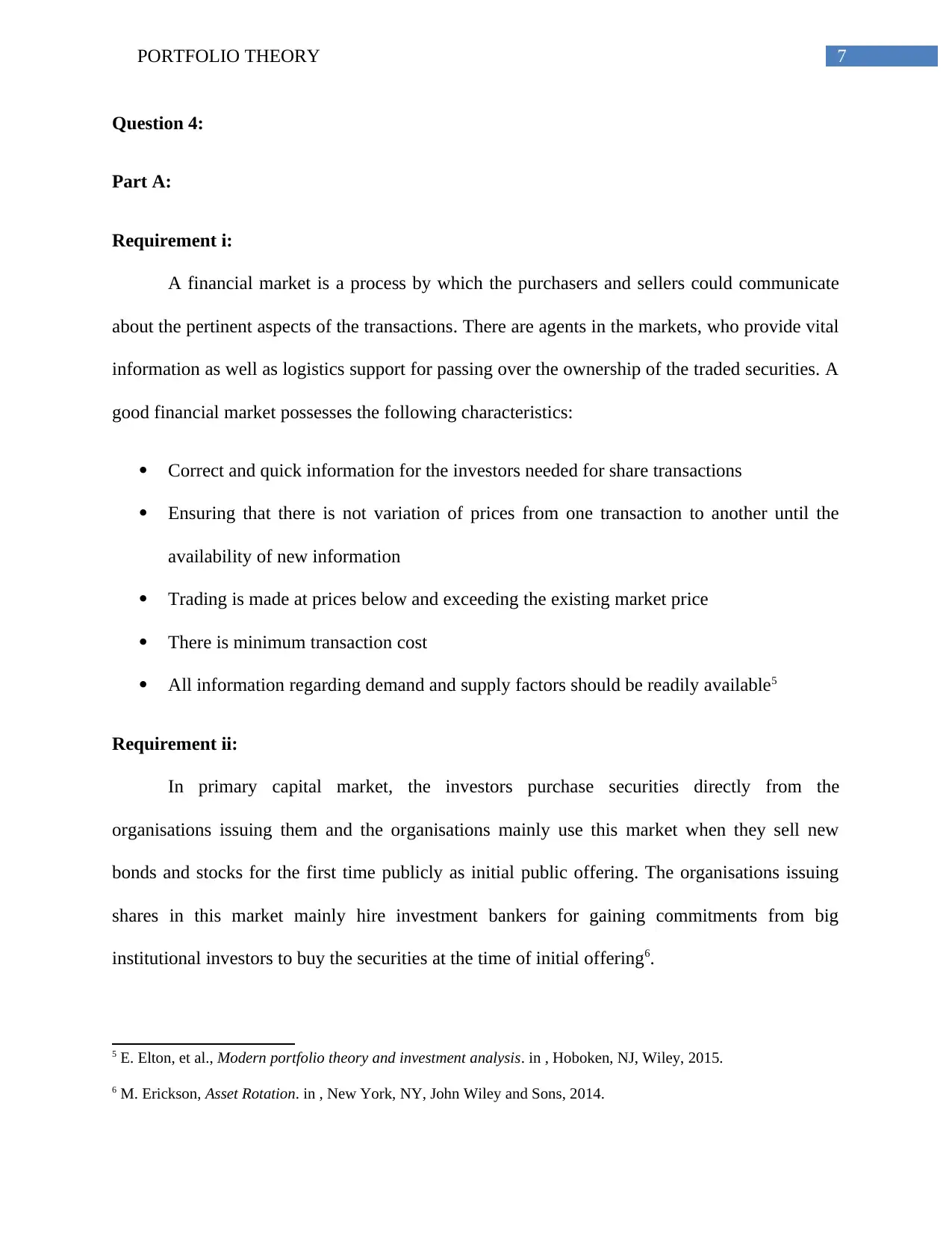
7PORTFOLIO THEORY
Question 4:
Part A:
Requirement i:
A financial market is a process by which the purchasers and sellers could communicate
about the pertinent aspects of the transactions. There are agents in the markets, who provide vital
information as well as logistics support for passing over the ownership of the traded securities. A
good financial market possesses the following characteristics:
Correct and quick information for the investors needed for share transactions
Ensuring that there is not variation of prices from one transaction to another until the
availability of new information
Trading is made at prices below and exceeding the existing market price
There is minimum transaction cost
All information regarding demand and supply factors should be readily available5
Requirement ii:
In primary capital market, the investors purchase securities directly from the
organisations issuing them and the organisations mainly use this market when they sell new
bonds and stocks for the first time publicly as initial public offering. The organisations issuing
shares in this market mainly hire investment bankers for gaining commitments from big
institutional investors to buy the securities at the time of initial offering6.
5 E. Elton, et al., Modern portfolio theory and investment analysis. in , Hoboken, NJ, Wiley, 2015.
6 M. Erickson, Asset Rotation. in , New York, NY, John Wiley and Sons, 2014.
Question 4:
Part A:
Requirement i:
A financial market is a process by which the purchasers and sellers could communicate
about the pertinent aspects of the transactions. There are agents in the markets, who provide vital
information as well as logistics support for passing over the ownership of the traded securities. A
good financial market possesses the following characteristics:
Correct and quick information for the investors needed for share transactions
Ensuring that there is not variation of prices from one transaction to another until the
availability of new information
Trading is made at prices below and exceeding the existing market price
There is minimum transaction cost
All information regarding demand and supply factors should be readily available5
Requirement ii:
In primary capital market, the investors purchase securities directly from the
organisations issuing them and the organisations mainly use this market when they sell new
bonds and stocks for the first time publicly as initial public offering. The organisations issuing
shares in this market mainly hire investment bankers for gaining commitments from big
institutional investors to buy the securities at the time of initial offering6.
5 E. Elton, et al., Modern portfolio theory and investment analysis. in , Hoboken, NJ, Wiley, 2015.
6 M. Erickson, Asset Rotation. in , New York, NY, John Wiley and Sons, 2014.
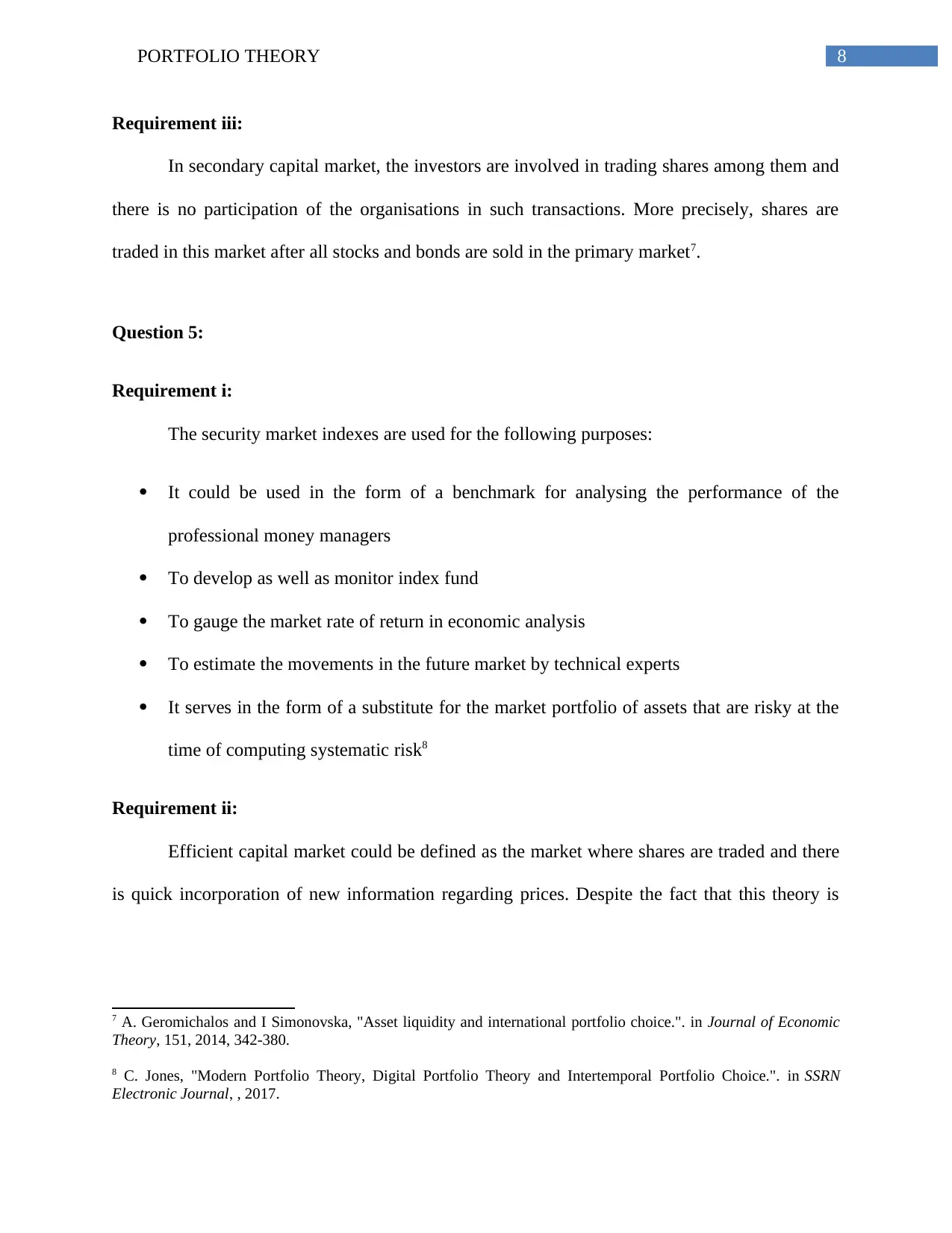
8PORTFOLIO THEORY
Requirement iii:
In secondary capital market, the investors are involved in trading shares among them and
there is no participation of the organisations in such transactions. More precisely, shares are
traded in this market after all stocks and bonds are sold in the primary market7.
Question 5:
Requirement i:
The security market indexes are used for the following purposes:
It could be used in the form of a benchmark for analysing the performance of the
professional money managers
To develop as well as monitor index fund
To gauge the market rate of return in economic analysis
To estimate the movements in the future market by technical experts
It serves in the form of a substitute for the market portfolio of assets that are risky at the
time of computing systematic risk8
Requirement ii:
Efficient capital market could be defined as the market where shares are traded and there
is quick incorporation of new information regarding prices. Despite the fact that this theory is
7 A. Geromichalos and I Simonovska, "Asset liquidity and international portfolio choice.". in Journal of Economic
Theory, 151, 2014, 342-380.
8 C. Jones, "Modern Portfolio Theory, Digital Portfolio Theory and Intertemporal Portfolio Choice.". in SSRN
Electronic Journal, , 2017.
Requirement iii:
In secondary capital market, the investors are involved in trading shares among them and
there is no participation of the organisations in such transactions. More precisely, shares are
traded in this market after all stocks and bonds are sold in the primary market7.
Question 5:
Requirement i:
The security market indexes are used for the following purposes:
It could be used in the form of a benchmark for analysing the performance of the
professional money managers
To develop as well as monitor index fund
To gauge the market rate of return in economic analysis
To estimate the movements in the future market by technical experts
It serves in the form of a substitute for the market portfolio of assets that are risky at the
time of computing systematic risk8
Requirement ii:
Efficient capital market could be defined as the market where shares are traded and there
is quick incorporation of new information regarding prices. Despite the fact that this theory is
7 A. Geromichalos and I Simonovska, "Asset liquidity and international portfolio choice.". in Journal of Economic
Theory, 151, 2014, 342-380.
8 C. Jones, "Modern Portfolio Theory, Digital Portfolio Theory and Intertemporal Portfolio Choice.". in SSRN
Electronic Journal, , 2017.
⊘ This is a preview!⊘
Do you want full access?
Subscribe today to unlock all pages.

Trusted by 1+ million students worldwide
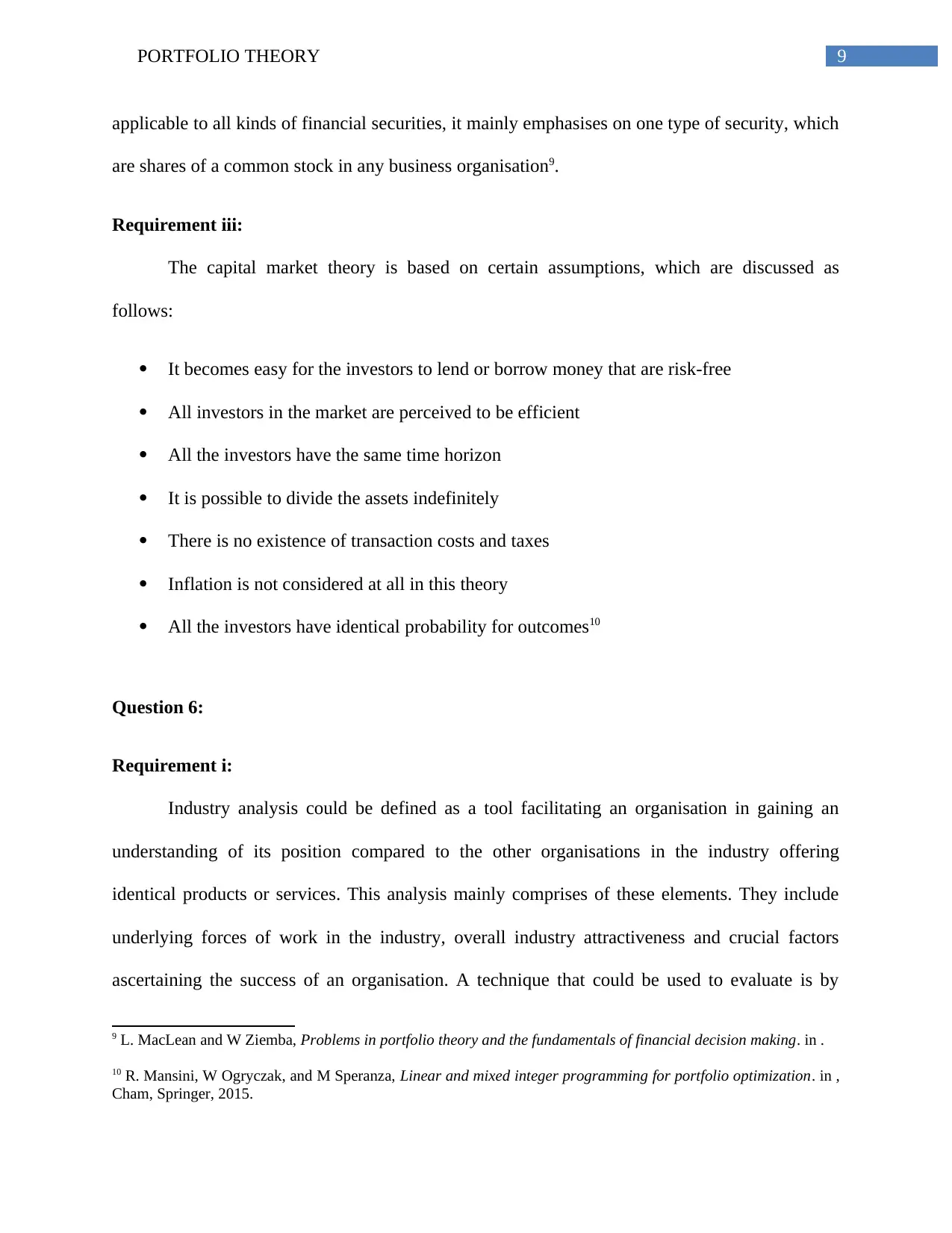
9PORTFOLIO THEORY
applicable to all kinds of financial securities, it mainly emphasises on one type of security, which
are shares of a common stock in any business organisation9.
Requirement iii:
The capital market theory is based on certain assumptions, which are discussed as
follows:
It becomes easy for the investors to lend or borrow money that are risk-free
All investors in the market are perceived to be efficient
All the investors have the same time horizon
It is possible to divide the assets indefinitely
There is no existence of transaction costs and taxes
Inflation is not considered at all in this theory
All the investors have identical probability for outcomes10
Question 6:
Requirement i:
Industry analysis could be defined as a tool facilitating an organisation in gaining an
understanding of its position compared to the other organisations in the industry offering
identical products or services. This analysis mainly comprises of these elements. They include
underlying forces of work in the industry, overall industry attractiveness and crucial factors
ascertaining the success of an organisation. A technique that could be used to evaluate is by
9 L. MacLean and W Ziemba, Problems in portfolio theory and the fundamentals of financial decision making. in .
10 R. Mansini, W Ogryczak, and M Speranza, Linear and mixed integer programming for portfolio optimization. in ,
Cham, Springer, 2015.
applicable to all kinds of financial securities, it mainly emphasises on one type of security, which
are shares of a common stock in any business organisation9.
Requirement iii:
The capital market theory is based on certain assumptions, which are discussed as
follows:
It becomes easy for the investors to lend or borrow money that are risk-free
All investors in the market are perceived to be efficient
All the investors have the same time horizon
It is possible to divide the assets indefinitely
There is no existence of transaction costs and taxes
Inflation is not considered at all in this theory
All the investors have identical probability for outcomes10
Question 6:
Requirement i:
Industry analysis could be defined as a tool facilitating an organisation in gaining an
understanding of its position compared to the other organisations in the industry offering
identical products or services. This analysis mainly comprises of these elements. They include
underlying forces of work in the industry, overall industry attractiveness and crucial factors
ascertaining the success of an organisation. A technique that could be used to evaluate is by
9 L. MacLean and W Ziemba, Problems in portfolio theory and the fundamentals of financial decision making. in .
10 R. Mansini, W Ogryczak, and M Speranza, Linear and mixed integer programming for portfolio optimization. in ,
Cham, Springer, 2015.
Paraphrase This Document
Need a fresh take? Get an instant paraphrase of this document with our AI Paraphraser
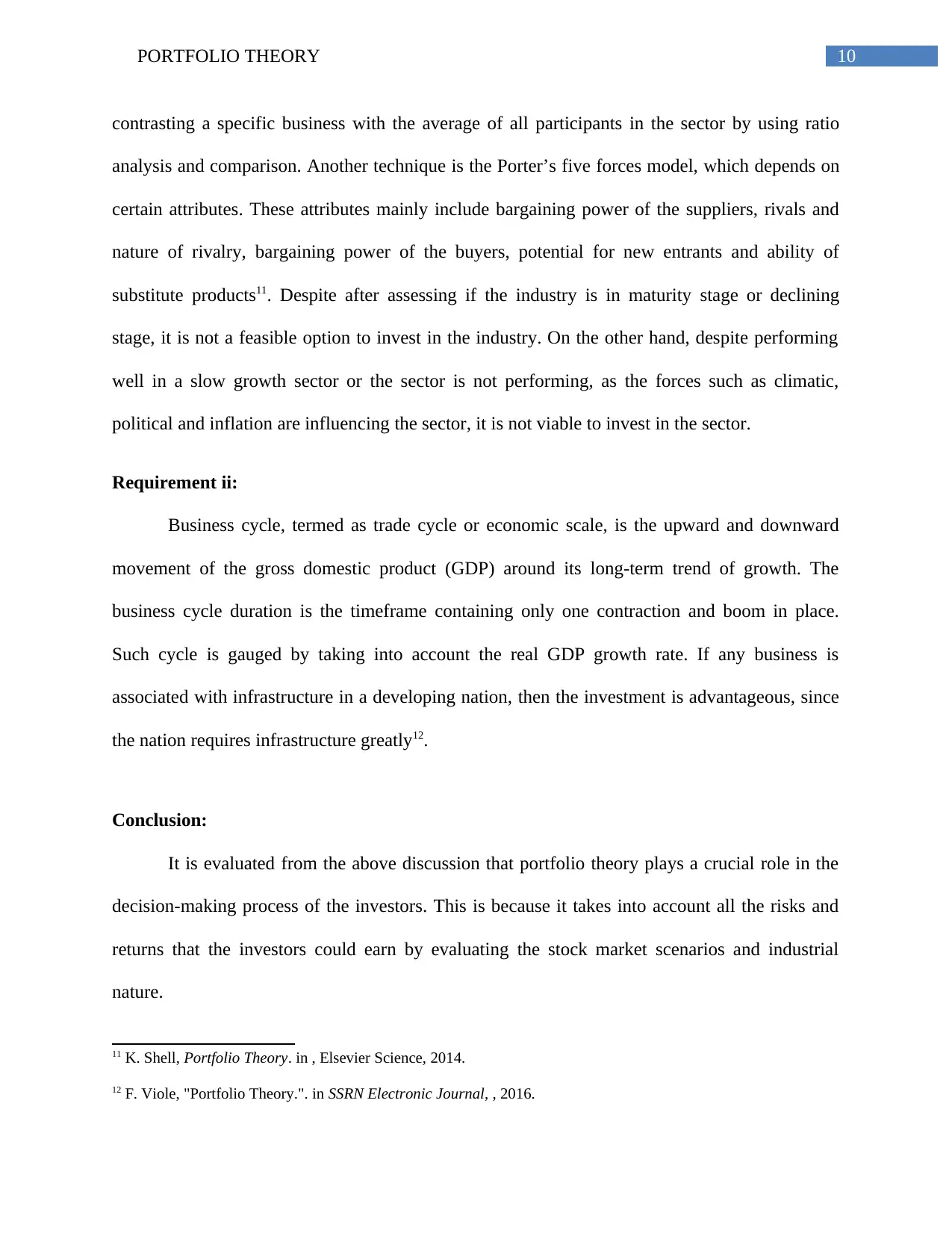
10PORTFOLIO THEORY
contrasting a specific business with the average of all participants in the sector by using ratio
analysis and comparison. Another technique is the Porter’s five forces model, which depends on
certain attributes. These attributes mainly include bargaining power of the suppliers, rivals and
nature of rivalry, bargaining power of the buyers, potential for new entrants and ability of
substitute products11. Despite after assessing if the industry is in maturity stage or declining
stage, it is not a feasible option to invest in the industry. On the other hand, despite performing
well in a slow growth sector or the sector is not performing, as the forces such as climatic,
political and inflation are influencing the sector, it is not viable to invest in the sector.
Requirement ii:
Business cycle, termed as trade cycle or economic scale, is the upward and downward
movement of the gross domestic product (GDP) around its long-term trend of growth. The
business cycle duration is the timeframe containing only one contraction and boom in place.
Such cycle is gauged by taking into account the real GDP growth rate. If any business is
associated with infrastructure in a developing nation, then the investment is advantageous, since
the nation requires infrastructure greatly12.
Conclusion:
It is evaluated from the above discussion that portfolio theory plays a crucial role in the
decision-making process of the investors. This is because it takes into account all the risks and
returns that the investors could earn by evaluating the stock market scenarios and industrial
nature.
11 K. Shell, Portfolio Theory. in , Elsevier Science, 2014.
12 F. Viole, "Portfolio Theory.". in SSRN Electronic Journal, , 2016.
contrasting a specific business with the average of all participants in the sector by using ratio
analysis and comparison. Another technique is the Porter’s five forces model, which depends on
certain attributes. These attributes mainly include bargaining power of the suppliers, rivals and
nature of rivalry, bargaining power of the buyers, potential for new entrants and ability of
substitute products11. Despite after assessing if the industry is in maturity stage or declining
stage, it is not a feasible option to invest in the industry. On the other hand, despite performing
well in a slow growth sector or the sector is not performing, as the forces such as climatic,
political and inflation are influencing the sector, it is not viable to invest in the sector.
Requirement ii:
Business cycle, termed as trade cycle or economic scale, is the upward and downward
movement of the gross domestic product (GDP) around its long-term trend of growth. The
business cycle duration is the timeframe containing only one contraction and boom in place.
Such cycle is gauged by taking into account the real GDP growth rate. If any business is
associated with infrastructure in a developing nation, then the investment is advantageous, since
the nation requires infrastructure greatly12.
Conclusion:
It is evaluated from the above discussion that portfolio theory plays a crucial role in the
decision-making process of the investors. This is because it takes into account all the risks and
returns that the investors could earn by evaluating the stock market scenarios and industrial
nature.
11 K. Shell, Portfolio Theory. in , Elsevier Science, 2014.
12 F. Viole, "Portfolio Theory.". in SSRN Electronic Journal, , 2016.

11PORTFOLIO THEORY
⊘ This is a preview!⊘
Do you want full access?
Subscribe today to unlock all pages.

Trusted by 1+ million students worldwide
1 out of 14
Related Documents
Your All-in-One AI-Powered Toolkit for Academic Success.
+13062052269
info@desklib.com
Available 24*7 on WhatsApp / Email
![[object Object]](/_next/static/media/star-bottom.7253800d.svg)
Unlock your academic potential
Copyright © 2020–2025 A2Z Services. All Rights Reserved. Developed and managed by ZUCOL.




